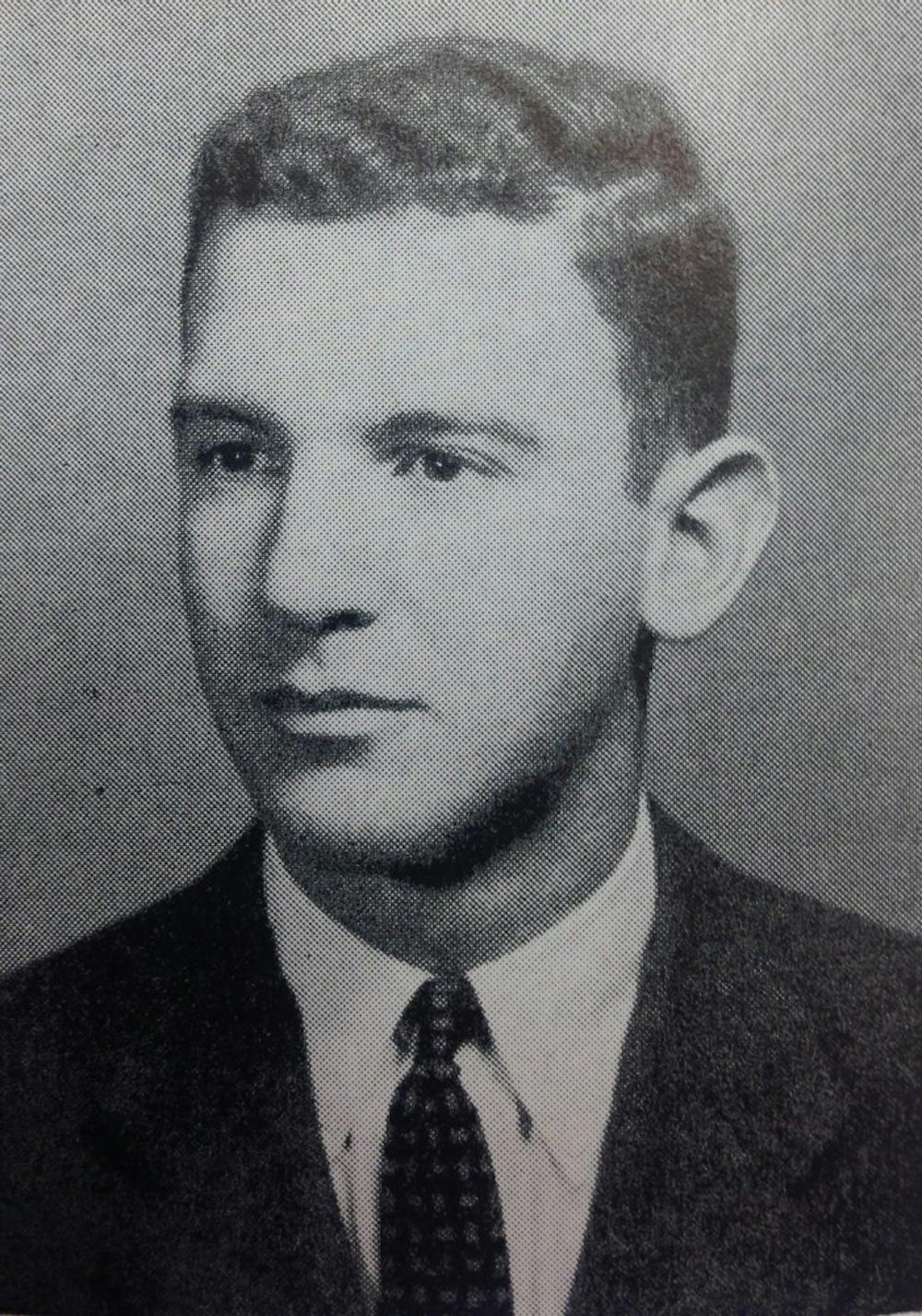Peter Lewis ’55, who, as the CEO of Progressive Insurance, was notable for being a champion of individuals taking charge of their own decisions, conveyed the same message as a young eating club officer at Princeton.
As treasurer of the now defunct Dial Lodge Club, which occupied the building that now holds the Bendheim Center for Finance, Lewis once resolved a conflict by appealing the president to make a decision, rather than wait for an informal consensus to be reached.
“We had a difficult problem with a lot of hemming and hawing where different solutions were proposed,” Richard May ’55, then-Dial Lodge president and a classmate of Lewis, said. “And he just said, ‘One person’s got to make the decision. You’re the President. You do it.’ ” After that statement, May explained, the meeting concluded and he made his decision.
The incident, he said, demonstrated one of Peter Lewis’ most notable traits: his tendency to make an individual decision and stand by it, rather than to hide behind a bland committee solution.
More than a dozen interviews and a review of his student records show that Lewis was an independent thinker unafraid of sharing unpopular thoughts. At the University, he was a member of the varsity crew team and wrote his senior thesis about auto insurance, an industry in which his family owned a small business of only 40 employees at the time. Lewis later took over the firm, Progressive,growing it into the giant it is now.
Although Lewis’ college yearbook biography called him a Republican, he later became an outspoken supporter of progressive causes. Lewis reportedly has directly funded the passage of almost every marijuana reform in the past couple decades and began using marijuana after he had a leg partially amputated in 1998. However, a friend said that Lewis’ marijuana use was not always strictly medical and that it even played a role in family interactions.
Lewis, who died on Nov. 23 at his home in Coconut Grove, Fla. at the age of 80, was also the most generous trustee in recorded history, having donated $233 million to the University throughout his lifetime. He was born in Cleveland in 1933 and attended Cleveland Heights High School before coming to Princeton. He was also a generous donor to Ohio-based charities.
“Progressive may be the greatest company in the history of the world,” Lewis’ long-time philanthropic adviser Jennifer Frutchy said in her eulogy at Lewis’s funeral, “but what is not disputable, is that he was one of the greatest human beings in the history of the world.”
A thesis on auto insuranceWhen Lewis was a senior majoring in the Wilson School, he requested a special permission in order to drop a course, Chinese Art, in order to have more time to complete his senior thesis. His thesis adviser backed him up.
“He has had a very strong and earnest interest in pursuing his study beyond the normal limits of a senior thesis,” his advisor, former politics professor Marver Bernstein, wrote in a letter on his behalf.

Lewis’ thesis was titled “The Financially Irresponsible Motorist: A Problem in Practical Politics” and was submitted jointly to the Department of Politics and the Woodrow Wilson School. The thesis was a study of “compulsory automobile insurance and related problems of public policy,” Bernstein wrote.
In the case of Lewis, automobile insurance ran in the family. Lewis’ father, Joseph Lewis, had founded Progressive in 1937 with business partner Jack Green.
He was enrolled in the Air Sciences program during freshman year, but left the program in 1952, noting that after the accidental death of his younger brother, his connection to the Armed Forces was causing his parents an undue amount of worry, a letter he submitted to the program read.
Classmate Markley Boyer ’55 explained in an interview that as the Korean War was going on at the time, every student at the University had to enroll in the sciences program of the Army, Navy, Air Force or Marines division of the Reserve Officers’ Training Corps.
Lewis’ roommate was Paul Sigler ’55, a renowned molecular biologist at Yale who died in 2000.
Robert Haselkorn ‘56, now a professor of chemistry at the University of Chicago, explained that he was very good friends with Sigler and, by extension, also became good friends with Lewis. Haselkorn added that he knew Sigler through chemistry; as they were both chemistry majors, they would often meet together to work on chemistry.
“Pete learned his chemistry by osmosis,” Haselkorn said, joking about the friendship between the three.
Haselkorn explained that he also knew Lewis through their mutual participation in varsity crew, where Lewis was a letter winner. Lewis was the team’s manager at the time, Haselkorn added, and had the responsibility of organizing the trips to and from the team’s various games. Princeton undergraduates were not allowed to have a car on campus at the time, but Lewis had successfully applied for that privilege citing his managerial position on the crew team.
“He was a great guy,” Haselkorn said. “Very friendly, very helpful, very social. I counted him as a great, great friend.”
Lewis was also involved in the Dial Lodge eating club, which he joined in the spring of his sophomore year. He was treasurer from March 1954 to March 1955, and his classmate May, the then-president, said that as treasurer, he ran the business end of the club, which included managing people’s meal plans, making sure the help got paid and paying the bills.
In addition to crew and Dial Lodge, Peter Lewis participated in intramural softball, intramural basketball and the Hillel Foundation.
Lewis applied to The Ohio State University College of Law for the Fall Quarter of 1955, although it is unclear if he got in. In any case, he never enrolled.
“Mr. Lewis has participated widely in extracurricular activities and has been an excellent citizen of the undergraduate community,” then-Dean of Students, William D’O. Lippincott, wrote in a letter to the law school dean of The Ohio State University.
Following graduation, Lewis joined his late father’s company, who died when Lewis was a junior in high school, as an underwriting trainee.
Back in the family business
As CEO of Progressive, a position he assumed in 1965, Lewis had a soft spot for colorful annual reports, complemented by “fine art.”
Mark Schwartz, president of the design firm Nesnadny + Schwartz, which produced Progressive’s annual report for more than 30 years said that from the beginning of their business relationship, Lewis wanted fine art to be part of the company’s annual report.
“It’s kind of a metaphor for what the company was about,” Schwartz said. “Creativity and problem solving and thinking outside the box, changing the status quo. Peter had that vision.”
Under Lewis’ leadership, Progressive grew from 40 employees to the fourth-largest private passenger auto insurance group in the United States.
As leader of Progressive Insurance, Lewis revolutionized the auto insurance industry by focusing on insurance for high-risk drivers who had often been rejected by other insurers.
Current Progressive CEO Glenn Renwick said that Lewis’ innovative business model was a reflection of what he knew from his father’s establishment and subject matter that interested him. Before working at Progressive, Lewis had already done research on the problem of financially irresponsible motorists, culminating in the senior thesis he wrote.
Under Lewis’ leadership, Progressive continued to set new standards for the auto industry. In 1990, Progressive launched “Immediate Response,” which provided customers with personal service immediately after they reported a claim. The company also became the first auto insurer to launch a website in 1995.
Renwick noted that Lewis always created a work environment where people could fully achieve their objectives. For example, he noted, a Progressive employee who is responsible for the auto results in Iowa gets to price those results and live with the consequences.
“A lot of lack of clarity in business comes when multiple parties believe they have a stake in an issue,” Renwick said. “It can be true, but ultimately there has to be a decider.”
Renwick explained that he thought that Lewis’ willingness to try new things was what made him an effective business leader, along with his honesty in admitting when his ideas were not working. Renwick also said that Lewis was an effective leader because of his transparency; he never had to second-guess any person or proposition.
After Lewis retired from the CEO position in 2000, he continued to serve as chairman of the board of Progressive. Lewis, Renwick said, had a lifetime of experiences with the company, and so he could serve in an advisory role both as chairman of the board and through an ongoing friendship with Renwick himself.
“He was, as he would often say, the biggest cheerleader of the company,” Renwick said.
Renwick added that Lewis would have retired from the Board in May 2014 due to the company’s age limits, but that it was the company’s hope and expectation that he would remain as director emeritus.
Peter Lewis became head of Progressive Insurance after he and his mother completed a leveraged buyout of the company in 1965. The company’s name was a reference to the progressivism of President Franklin Roosevelt and the New Deal.
Marijuana support
Lewis has attracted controversy for his outspoken support for the legalization of marijuana. The National Organization for the Reform of Marijuana Laws has estimated that Lewis has spent over $40 million in support of legal marijuana since the 1980s.
Allen St. Pierre, executive director of NORML, said in an interview that Lewis had directly funded the passage of virtually every major marijuana reform, particularly voter initiatives. St. Pierre added that while NORML was once the only major drug policy reform group around, twenty or more have now sprung up. He explained that while Lewis did not donate directly to those groups, he donated to institutions with grant-making capability, such as the Drug Policy Alliance of New York, that could then decide which drug reform groups to endow.
“Many of the drug policy reform groups today exist because of Peter’s philanthropy,” St. Pierre said.
In 1996, Lewis worked with magnate George Soros, former Men’s Wearhouse CEO George Zimmer and University of Phoenix Founder John Sperling to fund California’s Proposition 215, the first medical marijuana ballot initiative in the country.
But the more substantial relationship, Ethan Nadelmann, director and founder of the Drug Policy Alliance, said, involved bringing Lewis, Soros and Sperling into a seven-year partnership in which each of them contributed $10 million to a couple dozen policy initiatives around the country on legalizing medical marijuana, providing required treatment instead of incarceration for people arrested for drug possession and reforming asset forfeiture laws.
Nadelmann explained that Lewis felt a “personal connection” to the cause of medical marijuana law reform because of his desire to change public perceptions of the issue and his longtime connection to the American Civil Liberties Union.
“He always had a strong political commitment to civil liberties ideals and principles of personal autonomy,” Nadelmann said.
“As the kids got older, some of them enjoyed when Peter was using marijuana,” St. Pierre said. “He had a good and interesting relationship with his children that he thought few of his peers did.”
Lewis’ use of marijuana attracted public controversy in 2000, when he was arrested in New Zealand on three counts of drug possession after customs officials discovered “significant” amounts of hashish and marijuana in his briefcase. Lewis was released after one night in jail, and during his trial his lawyer noted that he used the marijuana on the advice of his doctor following a partial leg amputation in 1998.
St. Pierre said that he thinks that Peter’s legacy is bittersweet, sweet in the sense that he was the movement’s biggest and most important donor but bitter in the sense that some drug reform groups have become so dependent on his wealth that they did not look to other grassroots sources. He added while that although other wealthy men such as Zimmer and Shawn Parker, one of the founders of Facebook, have pledged money to the cause of drug reform, their contributions have not been as large as those of Peter Lewis.
There are two tiers of people to replace Lewis, St. Pierre explained, stakeholders and funders who may even come from within the industry itself. St. Pierre noted that in 2010, a medical marijuana dispensary operator named Richard Lee gave millions in support of the California voter initiative to legalize marijuana, while Peter Lewis and his fellow corporate executives only gave their contributions six weeks before the voting occurred, when they could no longer do any good.
Nadelmann said that he is optimistic that Lewis’ children will carry on his legacy, as they are aware of and respect their father’s commitment to the issue of legalizing marijuana. Nadelmann noted that Lewis had told him that he “now regarded [marijuana law reform] as his number one philanthropic commitment and passion.”
Lewis “did not see the University through rose-colored glasses”
Lewis’ most significant monetary contribution during his tenure as a trustee was the Lewis Center for the Arts, for which Lewis gave $101 million. In addition to funding the Center itself, Lewis’ gift provided support for an initiative to increase the number of arts programs as well as the number of artists teaching and collaborating at Princeton. Former University President Shirley Tilghman explained that Lewis’ contribution grew out of a conversation she and Lewis had about what she thought were some of the gaping holes in Princeton’s portfolio.
“I don’t think Peter was particularly interested in theater and dance, although he was passionate about the visual arts,” Tilghman said. “But I think he saw this as an area in which Princeton needed to become much better, and I think he was willing to make a historic gift in order to make it happen.”
Lewis also endowed the Lewis Library, which contains reference materials on the science and mathematics disciplines and was designed by internationally known architect Frank Gehry. Lewis and Gehry had by this time become great friends, Tilghman explained, adding that one of her first actions as president was to fly to Los Angeles with Lewis to discuss the construction of the building with Gehry.
Lewis’ first large gift, Tilghman said, was to endow the Lewis-Sigler Institute, housed in the Carl Icahn Laboratory, for $35 million. The Lewis-Sigler institute was established to do pioneering work with respect to the relationship between modern biology and the more quantitative sciences, and Lewis asked that the institute be named for his recently-deceased friend. Haselkorn, the classmate and long time friend, explained that he thought this tribute to be the ultimate sign of the friendship between Peter Lewis and Paul Sigler.
“He was a benefactor of the old school. He believed that the University knew best what the University needed, and he was willing to support whatever the University thought it needed most,” Tilghman said.
As a University Trustee, Peter Lewis served on the Grounds and Buildings Committee, fellow trustee Charlie Gibson ’65 said, adding that the Grounds and Buildings Committee is responsible for authorizing and overseeing new building projects. Gibson noted that work done as part of the Grounds and Buildings Committee included overseeing the five to six year process to achieve zoning approval for the Lewis Center for the Arts. Other committees Lewis served on included the Committee for Student Life and the Honorary Degrees Committee.
“When I went on the board,” Gibson said, “I didn’t know a whole lot about being on the board, so I tried to find a couple of board members that I thought I could emulate and before I knew that Lewis was a contributor, or about Lewis Library or any of that, I thought, this is a guy who shoots from the hip and whose judgments are well-considered and who is not afraid to speak out.”
One of Lewis’ great strengths as a trustee, Tilghman explained, was that he “did not see the University through rose-colored glasses,” instead seeing it as an imperfect institution that needed to be improved. Current Chair of the Board, Katie Hall ’80 said that she considered Lewis to be particularly valuable as a trustee because he was an independent thinker who always challenged people to do things better.
Former University President Harold Shapiro explained that he suggested Lewis as a potential trustee in 1998 because Lewis had independent ideas and brought up issues from a different angle.
“He struck me as someone who expressed his ideas,” Shapiro said, adding later that “he didn’t take it as an insult or something if one of his ideas was turned down or he ended up on the losing side of an issue.”
Shapiro also added that Lewis, as a businessman, wanted to be sure that the University was well-run.
“One of the reasons he became a big donor was that he came to the view that the University was well-managed,” Shapiro said.









